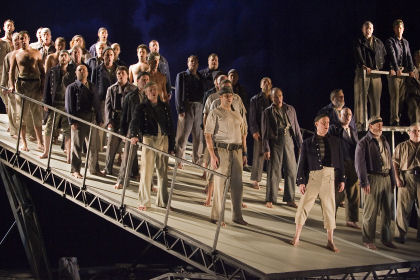 ENO
ENO
London Coliseum
3rd December 2005
There can surely be little wrong with any opera company which can mount so consummate a version of Billy Budd at the start of a new Britten cycle. ENO may - again - be going through difficulties behind the scenes but there was little wrong either on stage or in the pit for one of the most exciting evenings it has produced for a long time. Time is a great leveller, and where once Billy Budd could seem difficult both in the starkness of its text and its all male cast, this new production by Neil Armfield finds poetic and spiritual resonances in the most unlikely places. While Carl Friedrich Oberle's costumes keep us firmly in the late eighteenth century Brian Thomson's constantly moving platform gives us an abstract and emotionally neutral space on which the events unfold. It allowed us to focus entirely on the characters rather than any passing thoughts of naturalism. During the interval it suddenly occurred to me that the moving platform was remarkably similar to Sean Kenny's design for The Flying Dutchman at the Royal Opera House almost forty years ago - a production way ahead of its time and heavily booed as a result!
The lead singers were all exemplary. Timothy Robinson was a rather distant figure as Captain Vere, his ability as a commander overshadowed by his inability to make clear moral decisions. His introspection and inter-turmoil were finely honed as was his attention to musical detail. By contrast John Tomlinson's Claggart was all the more dangerous for its smooth exterior. No simple villain, this Master-at-Arms was in as much emotional confusion as his Captain, but his way out is through destruction rather than intellect. The unspoken tension was electric.
Between these two comes Simon Keenlyside's amazing Billy. Few singers can scale ladders and hang upside down while both singing and remaining in character. Keenlyside not only manages this but gives us a very complex reading of the central character. His Billy has a naivety in the earlier scenes which at times appears almost simple-minded, and his body language comes close to being out of control in the company of his superiors. Yet once he has killed Claggart it is as if he has found his purpose and the final scenes are physically relaxed and spiritually awake. It is a remarkable and most moving transformation. As a result his death, upsetting to the crew, is far less so to the audience. It is an accepted sacrifice. Only Vere cannot come to terms with it even years later.



Left to right: Billy Budd, Captain Vere, Claggart. Click on images for larger versions. All images © ENO/Clive Barda Photography
The myriad of minor parts are all well handled without any over-playing. The extended chorus is exceptional. The two big scenes are breathtaking, with an impact I cannot recall in any earlier large choral works at the Coliseum. Much of the credit goes not only to Chorus Master Martin Merry but to Andrew Litton's handling of the score from the pit. Clarity and movement throughout with near perfect balance even within the Coliseum's frequently difficult acoustic.
If only all night's at the opera were as good as this there would be little to worry about!
Further performances on 5, 8, 10, 12, 14 and 17 December
BH
